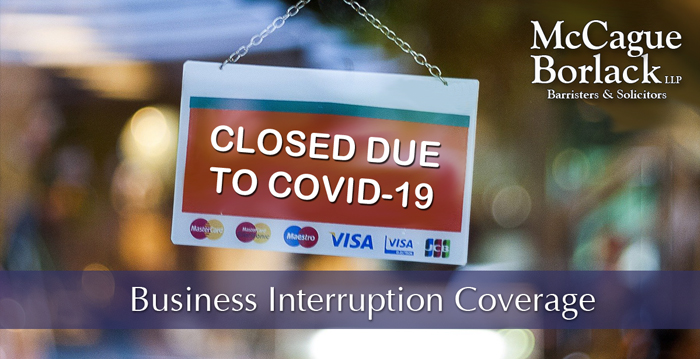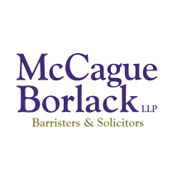While the Canadian Government has implemented various initiatives to assist employees and employers affected by these closures, for example, by covering 75% of salaries for qualifying businesses for up to 3 months,2 these initiatives do not account for the loss of profits which many businesses will sustain as a result of government-mandated and voluntary closures of businesses. This is further complicated by the fact that many businesses, in an effort to mitigate their losses have changed their business model, for example by offering delivery of groceries and take-out through services such as Uber Eats and Instacart. Consequently, insurers have and will continue to see, over the next few years, a significant surge in claims for business interruption.
Underwriting concerns: Balancing the risk
The IBC has a document outlining how coverage is triggered and how business interruption policies work. |
There are various issues operating for an insurer, in both quantifying and crystallizing the terms of the loss, to determine if coverage is triggered pursuant to any given policy of insurance. The Insurance Bureau of Canada (“IBC”) has published a document outlining how coverage is triggered and how business interruption policies work.3 The general consensus is that commercial insurance policies and traditional business interruption policies do not offer coverage for business interruption or supply chain disruption due to a pandemic such as COVID-19.
Colin Simpson, president and CEO of the Insurance Brokers Association of Ontario (IBAO), similarly opined in Canadian Underwriter that “[b]usiness interruption was never designed to respond to pandemics...[i]t’s generally linked to named perils within a policy, like floods and fires, for example. There’s a business interruption element to that, but a pandemic is something totally different...[i]f you were to look at it through a different lens, in the future, could the insurance industry respond to it [pandemic risk]? The answer would be no unless there are sufficient funds on the balance sheet to pay out claims of this magnitude. And we can see from the press that there are a number of businesses that are being interrupted.”
This is in accordance with the tenants of underwriting as it is at the “very heart of insurance” and the first step taken by an insurance company to generate premiums. The underwriter's role is to “evaluate a risk, estimate the potential exposure, determine the likelihood of loss, then make a decision whether or not to accept the application for insurance.”4
Similarly, when an organizational insured as with all insureds, seeks insurance coverage, they will consider and identify potential losses and threats which may cause a loss of profits. The insureds will try to balance coverage and premiums with the degree of foreseeable risks for which they seek coverage when entering into a contract of insurance.
It is a well established legal principle that “courts should be loath to support a construction which would either enable the insurer to pocket the premium without risk or the insured to achieve a recovery which could neither be sensibly sought nor anticipated at the time of the contract.”5 This process is summarized as you generally get what you pay for. As such, if an organization did not consider the possibility of a pandemic then they likely are not covered for a loss from same.
Defining risk: all risks or named perils
In terms of defining risks, insureds may choose a “named perils” business interruption policy which covers losses caused by the perils enumerated in a policy, or an “all-risk” policy which protects an insured against loss caused by essentially any risk that is not otherwise excluded.
A typical business income insurance clause reads as follows... |
A typical business income insurance clause reads as follows: “We will pay for the actual loss of business income you sustain due to the necessary suspension of your ‘operations’ during the period of ‘restoration.’ The suspension must be caused by the direct physical loss, damage, or destruction to property. The loss or damage must be caused by or result from a covered cause of loss.”6
The policy will define terms such as an actual loss which will generally refer to the actual loss sustained by the insured as a result of direct physical loss or damage to the insured’s property by a peril not otherwise excluded in the policy. In determining coverage for the business income, the insurer would be liable for the net income loss that results from “suspension” of operations – whether wholly or partially – due to a physical loss at the insured’s premises.7 In addition, in terms of determining a period of restoration, coverage would be afforded for the loss of business income only during the time period required to rebuild, repair, or replace the damaged property.8
It is clear that these policies generally contemplate coverage when there a nexus to a loss of property, and in instances where there is no such nexus is otherwise excluded. Notwithstanding the requirement for such a nexus, some policies may afford coverage in those instances.
Civil or Military Prohibitions: The Government made me do it
In contemplating coverage with regard to the loss of use of premises, it is common for commercial policies to extend coverage where the loss of use is caused by an order of civil or military authority, as is currently the case of COVID-19. An insured may claim for the actual loss sustained during the length of time when access to a described premise is specifically prohibited. However, there may be a limit imposed by an insurer with regard to the maximum allowable claim under any such endorsement.
For example Hub International, in a publication on their product offerings, notes, that there are a few important conditions that must be met for their civil authority insurance extension to apply:
- The denial of access must be due to an incident of physical damage to a nearby property;
- Damage to that nearby property must be due to a peril covered under your insurance policy;
- There is a limit to the length of time the BI coverage applies. It is usually between 15 and 30 days; and
- BI coverage almost always has a deductible in the form of a waiting period. The typical range is 24-72 hours.9
Even though this endorsement may afford coverage in very specific situations, there are still obstacles for any insured, which would preclude coverage. Further, there is still a requirement that the loss of use is connected to tangible property, as insured under the policy. In determining any such loss, the interpretation of an occurrence, premises, and physical or actual loss will be determinative and generally contemplated at the time the policy was issued. Other issues to consider will be whether there is any coverage available when operations continue although there may be a reduction in profits, as seen in the food and hospitality industry.
Where do we go from here?
The policy will dictate what coverage is available to an insured. It is well established that in interpreting any policy of insurance, Courts will interpret ambiguous provision(s) narrowly and against the Insurer. As such, policy wording and interpretation is key in determining whether a specific policy extends coverage in these circumstances, and ought to be considered and assessed in the early stages of a claim. In terms of the policies that are currently in the market, it will be interesting to see the claims that arise and how the Courts interpret the business interruption provisions for many years to come.
It would be prudent for insurers to review their current wordings for future policies in the interim, in light of recent events, in order to avoid ambiguity which may result in judgment(s) or unnecessary litigation against them moving forward.
- Ontario Extends Business closures to stop the spread of COVID-19, April 3, 2020.
- Canada's COVID-19 Economic Response Plan - Canada Emergency Wage Subsidy.
- COVID-19 and business Insurance: How coverage is triggered, April 1, 2020.
- Underwriting Insurance.
- Consolidated Bathurst Export Ltd. v. Mutual Boiler & Machinery Insurance Co., 1979 CanLII 10 (SCC), [1980] 1 S.C.R. 888, at para. 26 (cited with approval in Non-Marine Underwriters, Lloyd’s of London v. Scalera, [2000] 1 S.C.R. 551 at para. 71, 2000 SCC 24).
- Business Interruption Insurance: 8 Terms to Help You Understand What is Covered.
- Ibid.
- Ibid.
- Civil Authority Insurance Requirement, August 11, 2017.


